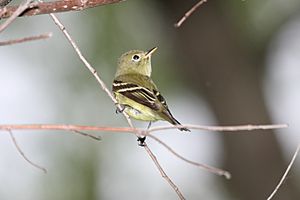Yellow-bellied flycatcher facts for kids
The yellow-bellied flycatcher (Empidonax flaviventris) is a small bird that loves to eat insects. It belongs to a bird family called tyrant flycatchers.
Quick facts for kids Yellow-bellied flycatcher |
|
|---|---|
 |
|
| Conservation status | |
| Scientific classification | |
| Genus: |
Empidonax
|
| Species: |
flaviventris
|
 |
|
Contents
What They Look Like
Adult yellow-bellied flycatchers have greenish feathers on their backs and wings. Their bellies and throats are a bright yellow. Sometimes, their chest looks a bit darker, like it has a light shadow.
They have a white or yellow ring around their eyes. This ring is smooth, not tear-shaped like some other flycatchers. You'll also see white or yellowish stripes on their black wings, which really stand out! Their beak is wide and flat. The top part of their beak is dark, but the bottom part is a cool orange-pink. They also have a shorter tail compared to other birds in their group.
Size and Weight
Here are some typical measurements for a yellow-bellied flycatcher:
- Length: 5.1 to 5.9 inches (13 to 15 centimeters)
- Weight: 0.3 to 0.6 ounces (9 to 16 grams)
- Wingspan: 7.1 to 7.9 inches (18 to 20 centimeters)
How They Find Food
Yellow-bellied flycatchers are clever hunters. They often wait on a branch, low or in the middle of a tree. When an insect flies by, they quickly fly out to catch it in mid-air! Sometimes, they even hover over leaves to grab a tasty bug. They mostly eat insects, but they might also snack on berries or seeds.
Their Song
The song of the yellow-bellied flycatcher sounds like a rough, descending "tse-berk." It can sometimes sound a bit like the Least flycatcher's song, which is a quicker, more even "che-bek."
Where They Live and Reproduce
These birds like to build their nests in wet, northern forests. They especially love spruce bogs, which are wet, marshy areas with spruce trees. You can find their breeding grounds across Canada and the northeastern United States.
They build a cup-shaped nest. It's usually made in sphagnum moss, which is a type of soft moss found on or very close to the ground.
Their Journey: Migration
When winter approaches, these birds don't stay in the cold. They migrate a long way south! They fly all the way to southern Mexico and Central America to spend the colder months.
See also
 In Spanish: Mosquero ventriamarillo para niños
In Spanish: Mosquero ventriamarillo para niños


